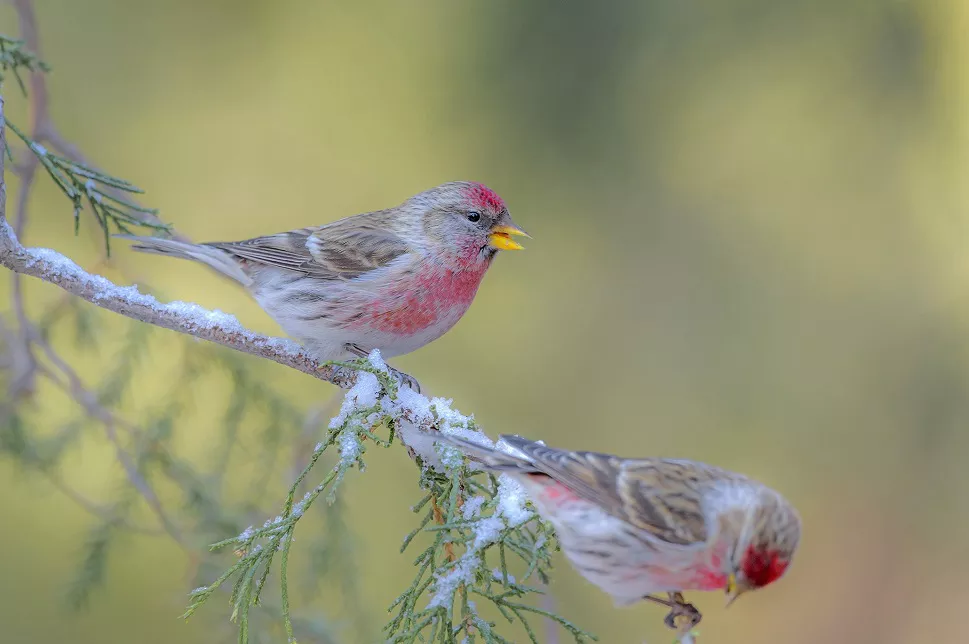The Arctic redpoll or hoary redpoll (Acanthis hornemanni) is a bird species in the finch family Fringillidae. length: 12-14cm, weight: 12-16g, Wingspan: 20-25 cm.
What does Arctic redpoll look like
The Arctic redpoll is similar in body, size and plumage to the Common Redpoll, but lighter in color. The upper body is off-white, the forehead and the front of the top of the head are vermilion, and a red spot is formed on the light-colored head, which is very eye-catching. Dip rose. The overlying feathers are white with brown feathers, the tail feathers are dark brown, and the feather margins are white. The small coverts on the wings are brown, the middle coverts and large coverts are dark brown with brown feather margins and white end spots, and two white wing spots are formed on the wings, the small wing feathers, primary coverts and flight feathers are dark brown, the feather margins Light brown, secondary and tertiary flight feathers with broad off-white feather margins. The eyes are black at first, the eye area, ear feathers and cheeks are nearly white, and the cheeks are slightly rosy. The chin is black, the rest of the lower body is white, the throat and chest are pink, and the sides of the chest and two flanks are slightly black longitudinal stripes.
Iris brown, lower bill yellow, upper bill dark brown, feet dark brown.
Arctic redpoll habitat
It mostly lives in secondary broad-leaved forests such as birch forests and poplar forests in low mountains and hills and plain grasslands at the foot of mountains, forest edge shrubs and farmland edge trees.
During the breeding period, it inhabits the arctic tundra shrubland, especially likes willow shrubs, birch shrubs, alder bushes and other shrubs that have been shrubbed due to climate conditions, and also goes in and out of rivers with sparse shrubs, On the shores of lakes, swamps, and adjacent rocky edges, and sometimes in dorsal taiga and forest margins.
Arctic redpoll living habit
The Arctic redpoll is partially migratory and tends to move southwards in November and north again in March and April.
It is an occasional winter migratory bird in China. In addition to the activities in pairs during the breeding season, they often form small groups of 5-7 or more than 10, and often move and forage on grasses, ears of grain, shrubs and branches.
What does Arctic redpoll eat
The food is mainly plant food, and Artemisia seeds and other weeds are the most in winter, especially when the mountains are covered by heavy snow, they often fly and land on the tops of the grass, and sometimes peck the fruits in an upside-down posture; some go to mountainous areas Scattered households peck at overwintering insects and spiders on rotten wood piles, or pick up relics on the roadside. In spring, it mostly feeds on young leaves, as well as small insects such as coleoptera; in autumn, it feeds on grains such as sorghum, millet and buckwheat. Also eats a lot of seeds and some insects.
Distribution area of Arctic redpoll
The Arctic redpoll is distributed in the sub-Arctic region, from Denmark (Greenland) to Norway (Lapland), Russia (Siberia), the United States (Alaska), Mongolia, Japan and northern China.
Arctic redpoll reproduction
Breeding takes place from May to July. The nest is built low down in a tree or bush and is neatly built with an outer layer of twigs, a middle layer of root fibers, fragments of juniper bark and lichens and an inner layer of down, willow buds and reindeer hair. Three to seven pale blue eggs with light reddish speckling are laid and incubated by the female. They hatch after about eleven days and the young fledge in about a further thirteen days.


 Facebook
Facebook  Instagram
Instagram  Youtube
Youtube 